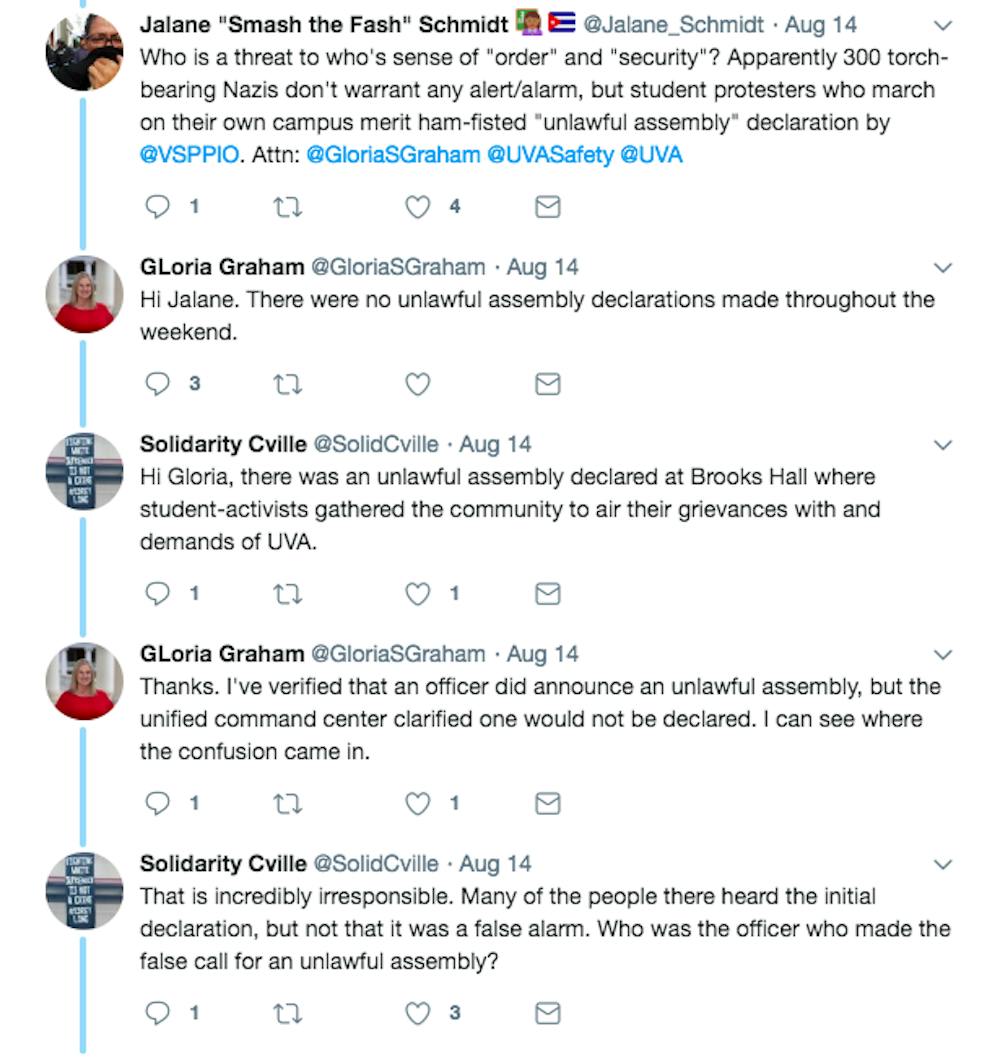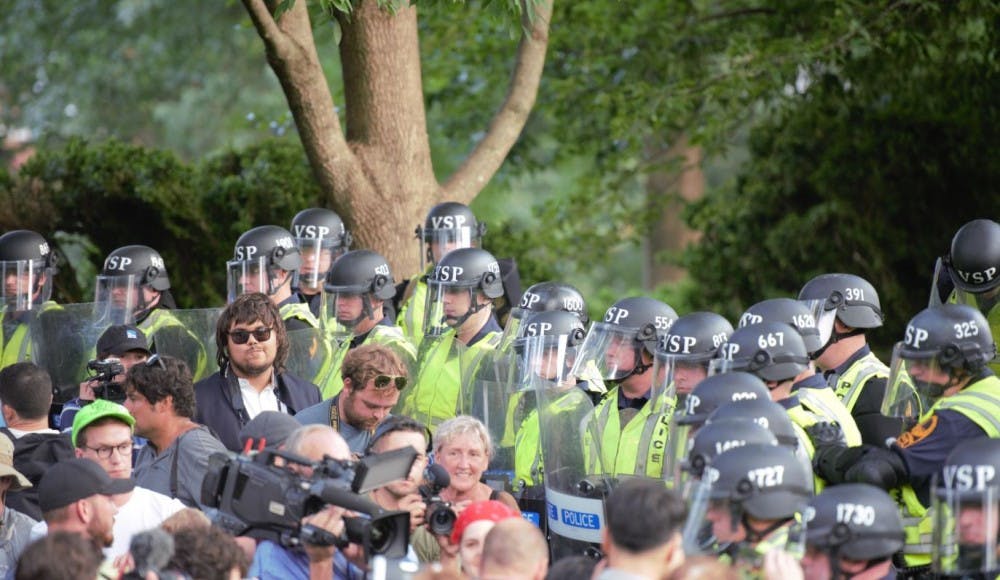A number of Charlottesville community members are raising concerns about how law enforcement officials responded to a U.Va. Students United rally held outside of Brooks Hall at the University last weekend, organized on the one-year anniversary of a white supremacist torch-lit march through Grounds. The large numbers of police present at last weekend’s rally and the tactics officers used were criticized at a City Council community listening session Tuesday and on social media this week.
In particular, Jalane Schmidt, an associate professor of religious studies at the University and a local activist, said in a text message to The Cavalier Daily that she saw Virginia State Police personnel assemble during the rally, and added that one of them announced the event to be an unlawful assembly.
“I saw the VSP lining up, one of them had a bullhorn, and I heard him announce: ‘This is an unlawful assembly,’” Schmidt said. “The crowd then retreated, [because] we feared being tear gassed.”
Schmidt said she and many others never heard an officer communicate to the crowd that there was in fact no unlawful assembly declared near Brooks Hall last Saturday. In a Twitter exchange between Schmidt, Solidarity Cville and Gloria Graham, U.Va.’s associate vice president for safety and security, Graham confirmed that “an officer did announce an unlawful assembly, but the unified command center clarified one would not be declared.”

However, Schmidt said there was no clear or meaningful distinction between the “announcement” or “declaration” of an unlawful assembly to the civilians at the rally last Saturday, and added that the responsible agencies should admit to the mistake rather than “parsing the difference between "communicated," or "announced" vs. "officially declared.”

In an email to The Cavalier Daily, Deputy University Spokesperson Wes Hester said an officer did communicate to the crowd near Brooks Hall that an unlawful assembly had been declared but added that the unified command center overseeing public safety during the weekend — including officials from the University, City of Charlottesville, Albemarle County, Virginia State Police and the Virginia Department of Emergency Management — decided against an official declaration of an unlawful assembly.
“A University police officer on Saturday evening initially communicated to the crowd gathered near Brooks Hall that the assembly was unlawful,” Hester said. “After receiving instructions from the Unified Command center that an unlawful assembly would not be declared at that time, the officer communicated that to the crowd. Fortunately, no official declaration of an unlawful assembly was necessary during the Saturday evening protest.”
At Tuesday’s City Council listening session, Kibiriti Majuto , a U.Va. Students United member, read a joint statement from Congregate Cville, Students United and the Charlottesville chapters of Black Lives Matter and Showing Up for Racial Justice regarding the rally and the law enforcement response to the Unite the Right anniversary weekend as a whole.
“This weekend in Charlottesville, we were able to join together in grief, rage, and celebration of resistance,” Majuto said. “Despite attempts by police to corral and intimidate us, we held space to listen to survivors of the physical and emotional trauma of last year’s White supremacist attack. We celebrated the collective resilience of our ongoing anti-racist community mobilization.”
Courtney Koelbel, a representative of the Central Virginia chapter of the National Lawyers Guild, also read a statement on behalf of the organization condemning the law enforcement response to and the heightened security restrictions — including metal detectors and a capacity limit — at the rally Saturday.
“When riot police inexplicably interrupted the event, community members, including a line of clergy, de-escalated the near-violence,” Koelbel said. “Students then took to the streets. Spanning the city, the 200 marchers successfully re-established their peaceful gathering outside of a militarized presence. Meanwhile, more than one hundred riot police, with canisters of chemical weapons at the ready, lined the then-abandoned Rotunda and Thomas Jefferson statue.”
Graduate College student Kyle Chattleton criticized the presence of law enforcement personnel in riot gear and their “kettle” assembly near the Academical Village Saturday, while students and community members were peacefully organizing near Brooks Hall. Kettling is a police tactic used to control large crowds in which personnel form lines or other barriers to block or control the movement of individuals.
“They responded by lining up next to the Academical Village in riot gear,” Chattleton said. “We act like lessons are being learned from last year so we are going to over police [this year]. Part of the solution is not seeing students peacefully protest on their terms and responding to that by saying, ‘Better get ready to kettle them.’”
In response to questions from speakers regarding the role of Charlottesville City Councilor Wes Bellamy in de-escalating conflicts between demonstrators and law enforcement personnel near Brooks Hall Saturday, Bellamy said he tried to mediate between the two.
“Even in this position when I saw the police marching … my blood pressure went up,” Bellamy said. “Just that conversation with them about, ‘Let’s understand where each other are coming from,’ and the lieutenant’s response was, ‘I can see your perspective, we are only here as a precaution.’”
Bellamy added that he wanted the police officers to understand why they might appear threatening to the demonstrators given their line formation and possession of shields. After he spoke with a lieutenant on the scene, Bellamy said the law enforcement personnel lowered their shields and tensions de-escalated.
After a standoff between demonstrators and law enforcement personnel Sunday at the intersection of Fourth Street and Water Street, Bellamy also announced that the Downtown Mall checkpoints and surrounding street barricades would be removed.
With regards to the white nationalist torch-lit march through Grounds Aug. 11, 2017, City resident Ann Marie Smith said she had yet to hear almost any public officials in the City or at the University apologize for the failings of law enforcement personnel to keep students and community members safe when demonstrators surrounded them at the Jefferson statue on the North side of the Rotunda. An independent review of last summer’s events by former U.S. Attorney Tim Heaphy described the response of the University Police Department to the torchlit rally as “woefully inadequate.”
However, Smith cited remarks from University President Jim Ryan at an event held Saturday morning at Old Cabell Hall, in which Ryan apologized to people who were attacked by white supremacists during the torch-lit rally last year. Ryan also apologized again at an event hosted by the Charlottesville-Albemarle NAACP Sunday evening.
“I heard Jim Ryan apologize at a ticketed event … but that was the first time I heard anyone take a mini-stab at apologizing for what an institution is responsible for,” Smith said.







